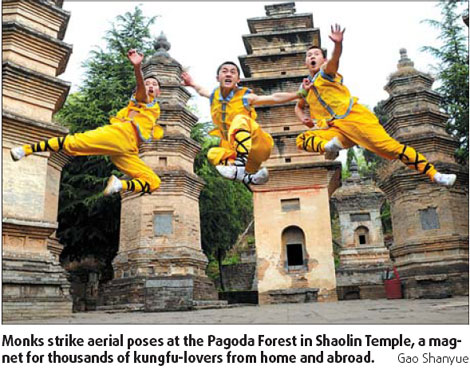
|
CHINA> Regional
 |
|
Taking one's breath away
By Alexis Hooi (China Daily)
Updated: 2008-09-11 09:33  "Home to the Yellow Emperor, where Buddha's light shines forth from Longmen and Shaolin's kungfu is known to all under heaven... welcome to Henan province." This is the grand greeting you get on your cellphone as you step off the train in the provincial capital of Zhengzhou. Henan, of course, is the birthplace of the Yellow Emperor or Huangdi, legendary progenitor of the Chinese people. Along the banks of its Yi River are the ancient Longmen Grottoes, one of the finest repositories of Buddhist cave art.
It is also here in Henan that monks of the famed Shaolin Temple are said to practice their formidable form of martial arts, in the shadow of Songshan Mountain. Songshan itself is the center of the world. Taoists in the Middle Kingdom consider the mountain a symbol of earth, the central point of the five elements that make up the universe. With its highest peak of Shaoshi at 1,512m, the looming highland leaves no doubt as to the gravity of its stature and can seem intimidating to visitors at first. But the adventurous trekker with a full day on his or her hands will be rewarded with a veritable feast of mind-boggling breccia rock formations, gravity-defying chevron faults and breathtaking views of China's central plains - along a seemingly treacherous path that often clings to red- and gray-colored cliff faces dotted with turfs of greenery. Take a breather on the nearest boulder off the track as you head into the occasional valley and the colossal mountain offers temporary reprieves in the form of whispering brooks, singing cicadas and that welcome waft of cool breeze. As you continue the climb, look up at the towering grandeur of Heaven's Gorge as it reaches into the clouds and walk weightlessly on the rope bridge along the Narrow Path of the Three Emperors - all else will seem to revolve underneath. The cardinal position accorded to Songshan is also reflected in the firmly entrenched reputation of Shaolin Temple being the origin of martial arts. Legend has it that the temple's first disciples in the 5th century mimicked the natural motions of birds and beasts as relief between long meditation sessions, a practice that evolved into physical and spiritual combat over the centuries. In the world of Chinese pugilistic novels and film, Shaolin monks, with their evil-subduing cudgels and diamond-hard fists grounded to perfection through years of tough training, have few rivals in other kungfu sects. Students of the local 20,000-strong Ta Gou school today still practice wushu on the temple's adjacent dirt fields, while foreigners who also want a bit of the action take up short-term classes to try out moves at the temple. Those with less time on their hands can be part of about half a million foreigners a year who experience Shaolin's temple halls, Buddhist relics and well-stocked souvenir shops. Weave through the Pagoda Forest, a cemetery containing the ashes of monks stored in more than 200 pagodas and steles donated by foreign martial arts schools. Or venture into the adjoining hills west of the temple, where the top of the 750-m-high Wuru Peak is marked by a three-story-tall, white-colored statue of Damo, the patriarch who first taught Shaolin monks martial arts and positioned the temple as the birthplace of Zen Buddhism in China. Close to the top of Wuru lies the cave where Damo sat meditating long enough to apparently leave a shadow on the wall - that slab of the cave is now housed in Shaolin Temple itself. |